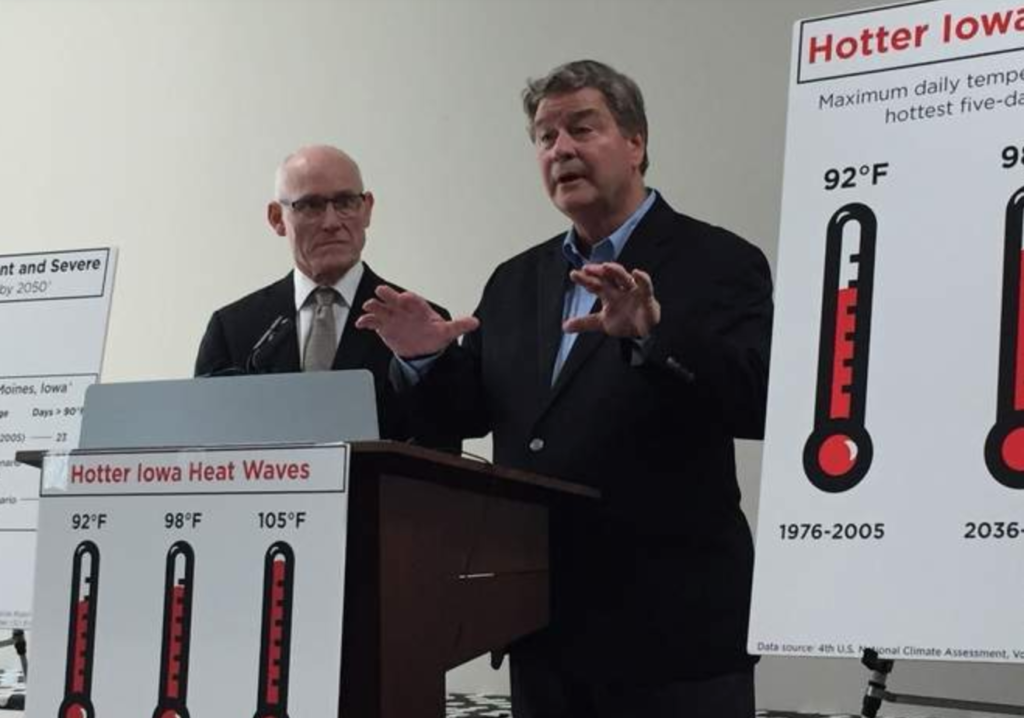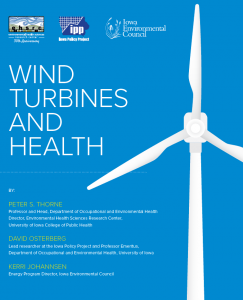Check out these important articles featured on the site The Conversation!
“North America’s summer of wildfire smoke: 2023 was only the beginning” by Dr. Charles Stanier, Dr. Gregory Carmichael, and Dr. Peter Thorne
Environmental Health Sciences Research Center
University of Iowa College of Public Health
Check out these important articles featured on the site The Conversation!
“North America’s summer of wildfire smoke: 2023 was only the beginning” by Dr. Charles Stanier, Dr. Gregory Carmichael, and Dr. Peter Thorne
Dr. Brandi Janssen and Jackie Curnick have published a project report in the Science Education & Civic Engagement International Journal. The paper titled, “Evaluating Knowledge Transfer after a Science Cafe: A Qualitative Approach for Rural Settings,” was included in the Winter 2022 edition of the journal.
View the article pdf by clicking the image below
A recent publication by EHSRC member Dr. Ashutosh Mangalam’s group was featured as an E-Factor Paper of the Month NIEHS Environmental Factor Newsletter as a Paper of the Month! The E-Factor Papers of the Month highlight the highest impact and most innovative research funded by NIEHS. Congratulations to the authors!
Citation: Jensen SN, Cady NM, Shahi SK, Peterson SR, Gupta A, Gibson-Corley KN, Mangalam AK. 2021. Isoflavone diet ameliorates experimental autoimmune encephalomyelitis through modulation of gut bacteria depleted in patients with multiple sclerosis. Sci Adv 7(28):eabd4595.
As written in Environmental Factor Newsletter:
A new NIEHS-funded study in mice showed that a diet rich in the plant-based compound isoflavone may protect against multiple sclerosis (MS). The isoflavone diet was only protective when the mice had gut microbes capable of breaking down isoflavones. MS is a disease in which the immune system attacks nerves in the brain and spinal cord, resulting in muscle weakness and loss of balance or coordination.
The researchers fed mice with MS characteristics an isoflavone-rich or isoflavone-free diet for six weeks. They measured levels of inflammatory cells in the brain and spinal cord, a hallmark of MS, and characterized the makeup of the gut microbiome.
Mice fed an isoflavone-free diet had more severe disease, with greater numbers of inflammatory cells in the brain and spinal cord, than mice fed isoflavone-rich diets. Isoflavone-free mice lacked isoflavone-metabolizing gut bacteria, which were abundant in mice fed the plant-based compounds. When the researchers fed mice isoflavones but removed isoflavone-metabolizing bacteria, the diet no longer protected against MS-like symptoms. When the bacteria were restored, the protective effect of the isoflavone diet returned. Furthermore, the researchers showed that isoflavone-free mice given equol, a metabolite produced when gut bacteria breakdown isoflavone, were also protected against MS.
Results suggest that the development and severity of MS is influenced by both diet and the makeup of the gut microbiome. According to the authors, results can inform therapies for patients with MS.
Dr. Brandi Janssen, Director of the EHSRC Community Engagement Core, collaborated with colleagues at Emory, University of North Carolina, and University of New Mexico to publish a paper about reporting back to communities. It was featured as a paper of the month on the NIEHS Environmental Factor newsletter. See write up below:
NIEHS grantees developed a framework and set of recommendations to help environmental health researchers return research results to study participants, a process called result report-back. According to the authors, report-back has the potential to improve environmental health education and communication and overall public health. Despite strong recommendations for report-back, researchers share results with study participants infrequently and inconsistently, the authors said.
To create the framework, the researchers used feedback from 35 community engagement practitioners who participated in a workshop at the 2018 NIEHS Partnerships for Environmental Public Health Annual Meeting. Workshop attendees responded to the prompt: “What are some specific issues that are relevant to reporting back research results to individuals or the larger community?” Participants then grouped similar responses and rated groups by importance to successful result report-back. The researchers used qualitative and quantitative methods to create a framework, called a concept map, to visualize relationships between responses.
Five themes emerged from this process. Listed from most to least important, the themes were: effective communication strategies, community knowledge and concerns, uncertainty, empowering action, and institutional review and oversight. Engaging community partners in the process of result report-back emerged as a unifying global theme. The researchers further examined responses and made recommendations to address challenges within and across themes.
Environmental health researchers and practitioners should address these five specific themes when planning and implementing their result report-back activities, say the authors.
Citation: Lebow-Skelley E, Yelton S, Janssen B, Erdei E, Pearson MA. 2020. Identifying issues and priorities in reporting back environmental health data. Int J Environ Res Public Health 17(18):6742.
Researchers for the Pulmonary Toxicology Facility and the Exposure Science Facility contributed to a paper in Infection Control & Hospital Epidemiology entitled, “Inactivation of SARS-CoV-2 and Diverse RNA and DNA Viruses on 3D Printed Surgical Mask Materials”.
View the paper here:
EHSRC Member Dr. Wei Bao published a study about Bisphenol A (BPA) and death risk. The team’s findings have been featured in an article on Newsweek.com
Here is an excerpt from piece, written by Kashmira Gander :
“The new study involved 3,883 adults in the U.S. aged 20 or over who were taking part in the U.S. National Health and Nutrition Examination Survey 2003-2008. The participants provided samples of their urine, and gave information including their age, sex, race, diet, and exercise levels.
Of the total volunteers, 344 died 10 years after the study started, including 71 from cardiovascular disease, and 75 from cancer.
Dr. Wei Bao Department, assistant professor in the College of Public Health at University of Iowa and colleagues found that those who had higher levels of BPA in their urine had a greater risk of dying by the end of the study.
Participants with the highest levels of BPA had a 51 percent higher risk of death from any cause. The link remained when the researchers accounted for factors that might put a person at higher risk of dying, they said.”
Article by Tom Snee, University of Iowa published here

A new study from the University of Iowa suggests that people who have higher levels of a chemical in their body that indicates exposure to commonly used insecticides die of cardiovascular disease at a significantly higher rate.
Findings from the study, published in the journal JAMA Internal Medicine, suggest those who have high levels of exposure to pyrethroid insecticides are three times more likely to die of cardiovascular disease than people with low or no exposure.
Wei Bao, assistant professor of epidemiology in the University of Iowa College of Public Health and the study’s corresponding author, says the findings come from an analysis of a nationally representative sample of American adults, not just those who work in agriculture. That means the findings have public health relevance to the general population.
He also cautions that as an observational study, the research does not determine if the people in the sample died as a direct result of their exposure to pyrethroids. He says that the results indicate a high likelihood of a link, but more research is needed to replicate the findings and determine the biological mechanisms.
Pyrethroids are among the list of commonly used insecticides with the largest market share and they constitute the majority of commercial household insecticides. They are found in numerous commercial insecticide brands and are used widely in agricultural, public, and residential settings for pest control. Metabolites of pyrethroids, such as 3-phenoxybenzoic acid, can be measured in the urine of people who are exposed to pyrethroids.
Bao and his team of researchers analyzed data on 3-phenoxybenzoic acid levels in urine samples collected from 2,116 adults aged 20 and over who participated in the United States National Health and Nutrition Examination Survey between 1999 and 2002. They cross-referenced mortality records to determine how many of those adults in their data sample had died by 2015 and of what cause.
They found that during an average 14 years of observation, those people who had the highest levels of 3-phenoxybenzoic acid in their urine samples were 56% more likely to have died of any cause by 2015 than people with the lowest levels of exposure. Cardiovascular disease was by far the leading cause of death, with a three times greater likelihood.
While Bao’s study did not determine how the subjects became exposed to pyrethroids, he says previous studies show that most exposure to pyrethroids is through food, as people who eat fruits and vegetables that have been sprayed with them ingest the chemical. Residential use of pyrethroids in gardens and homes for pest-control is also a significant source of exposure. Pyrethroids are also present in household dust in homes that apply these pesticides.
Bao notes that the market share of pyrethroid insecticides has increased since the 1999–2002 study period, which makes it likely the rate of cardiovascular disease-related deaths related to its exposure has increased, as well. However, Bao says, further investigation is needed to assess whether this hypothesis holds.
The paper, “Association Between Exposure to Pyrethroid Insecticides and Risk of All-Cause and Cause-Specific Mortality in the General US Adult Population,” was co-authored by Buyun Liu and Hans-Joachim Lehmler in the UI College of Public Health and Derek Simonsen, a UI graduate student in human toxicology. It was published in the Dec. 30, 2019, issue of JAMA Internal Medicine.
Members of the EHSRC, along with partners from around the state, have released the 2019 Iowa Climate Change Statement, focusing on extreme heat and heatwaves.
View the statement document here
View all of the Iowa Climate Change Statements from previous years here

Press Coverage of the Statement
Iowa Public Radio- Severe Heat Waves Will Likely Threaten Iowa Residents, Workers, Farmers
Cedar Rapids Gazette- Iowa scientists, educators warn time running out to combat climate change
Des Moines Register, written by EHSRC Member Dr. Jerry Schnoor –

The Environmental Health Sciences Research Center has collaborated with the Iowa Policy Project and the Iowa Environmental Council to publish a paper about Wind Turbines and Health. Read them here!